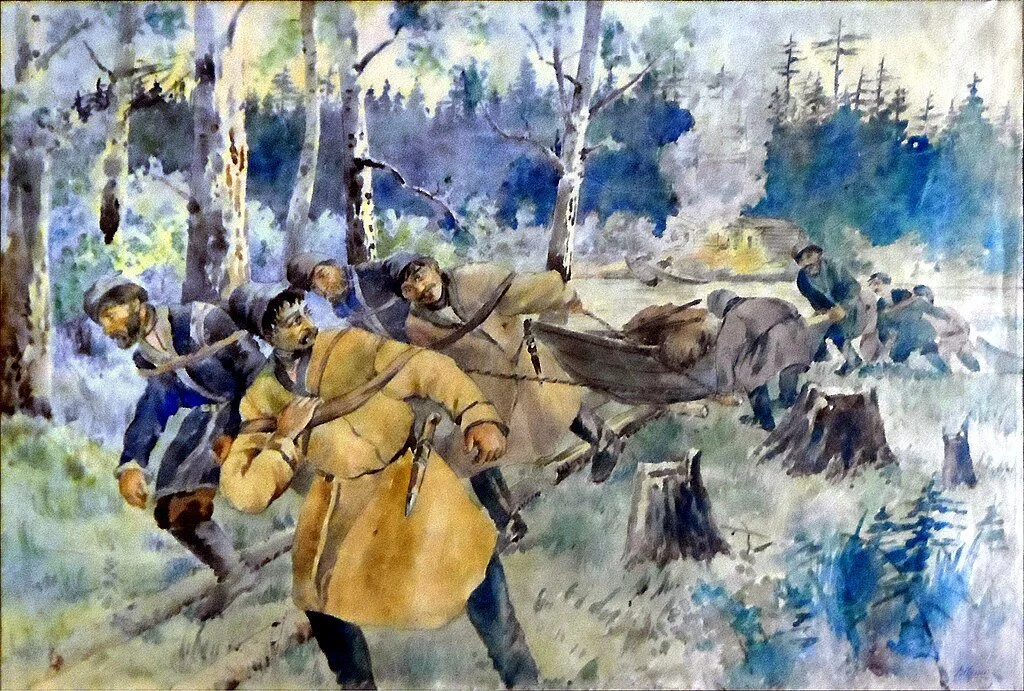“Advancement of the Promyshlenniki to the East” by V. G. Vagner. Promyshlenniki translates approximately to hunter-trapper frontiersmen. Back in 1725, it was unclear whether Czar Peter and Bering had prior knowledge that Asia and North America were not in fact connected, but the impetus for the exploration appears to have been a joint explorative/probing mission to determine how far west other European powers, especially Spain, had explored. After sailing into the sea which now bears his name, Bering initially failed to reach the North American mainland. It would be more than a decade before he embarked on a second expedition this time successfully reaching what is now Alaska in July 1741. Despite the impressive intrepidness and endurance made by the officers and men of the expedition the most immediate impact upon return to St. Petersburg was the procurement of rich furs, mainly sea otters. This later launched a gradual wave of highly enterprising traders, entrepreneurs and adventurers backed mostly by private or individual fortunes to tap into the fur rush, much like what the French and British had already been doing on the opposite side of the American continent. A relentless campaign ensued to harvest the highly sought after furs of sea otters, foxes, and various northern seals. Once one island/area was rapaciously depleted of furs the hunters and trappers merely moved on to the next and continued to exploit and slaughter. This had a horrific impact on the local native populace as they watched in horror and confusion as their abundant food and survival sources were destroyed and threatened with extinction. 1780s By the 1780s the chaotic free for all operations of independently operating Promyshlenniki steadily gave way as six competing companies arose much like the Hudson’s Bay Company in British North America. Under such companies which were typically named for their founder(s) such as the Sheilikhov-Golikov Company. Competition would increase but took on a more organized fashion as the first permanent Russian settlements soon began to emerge because of coordinated and sustained trapping operations. Despite some coordination and cooperation with the native populace, mainly Aleuts and Tlingits, relationships began to falter despite the pleadings and alleged interest in Native wellbeing of the distant and all too preoccupied monarch Catherine the Great. The all-too-common clash of cultures kept increasing in intensity and atrocities with several military encounters ensuing. The Natives never could gain a decisive edge given their lack of gunpowder and firearms and became fewer in number. In 1808 the Russians relocated their erstwhile capital of Russia America from Kodiak Island to Sitka. There they took advantage of secure and deep harbors as they expanded their shipbuilding operations utilizing the abundance of timber in the surrounding area. Consolidating their regional monopoly the Russians virtually controlled much of the Pacific fur trade from the Aleutians to Northern California, providing lucrative furs and pelts to the markets in Asia and North America, even trading consistently with the newly created United States. Russian ships likewise began to sail further south into the Pacific laying anchor at places such as Easter Island and the Hawaiian Archipelago, all at the behest of the Czar who was determined that Russia remain a major player on the global geopolitical stage. Mid Century Russia would hold onto its outposts in Alaska ever so tenuously well into the mid-19th century as it faced consistently mounting pressure from the British and American who similarly coveted Alaska and the Pacific Northwest’s strategic and economic potential. The Russian attention eastward would wane however with the emphasis on southern extension into the Caucasus’s and Central Asia would pit Russia and Great Britain against one another in both hot and cold conflicts such as the Crimean War and the so-called Great Game. In the 1850s, overhunting and trapping coupled with the bevy of conflicts abroad led to the Russian Empire devoting fewer men, material and resources to its outposts in the Pacific Northwest. Cognizant of Russia’s vulnerability from other European powers and prioritization of other regions the Czar decided to entertain and eventually approve a sale of Alaska to the United States in 1867 for the price of seven million dollars, roughly two cents per acre. Thus, ending the near century and a half legacy of Russian activity in North America. To this day the Orthodox Church is still a prominent institution in the now State of Alaska. A vestige harkening back to an often-overlooked chapter in American and Russian history.
http://www.historyisnowmagazine.com/blog/2025/11/20/russian-colonization-in-alaska-and-the-pacific-northwest


